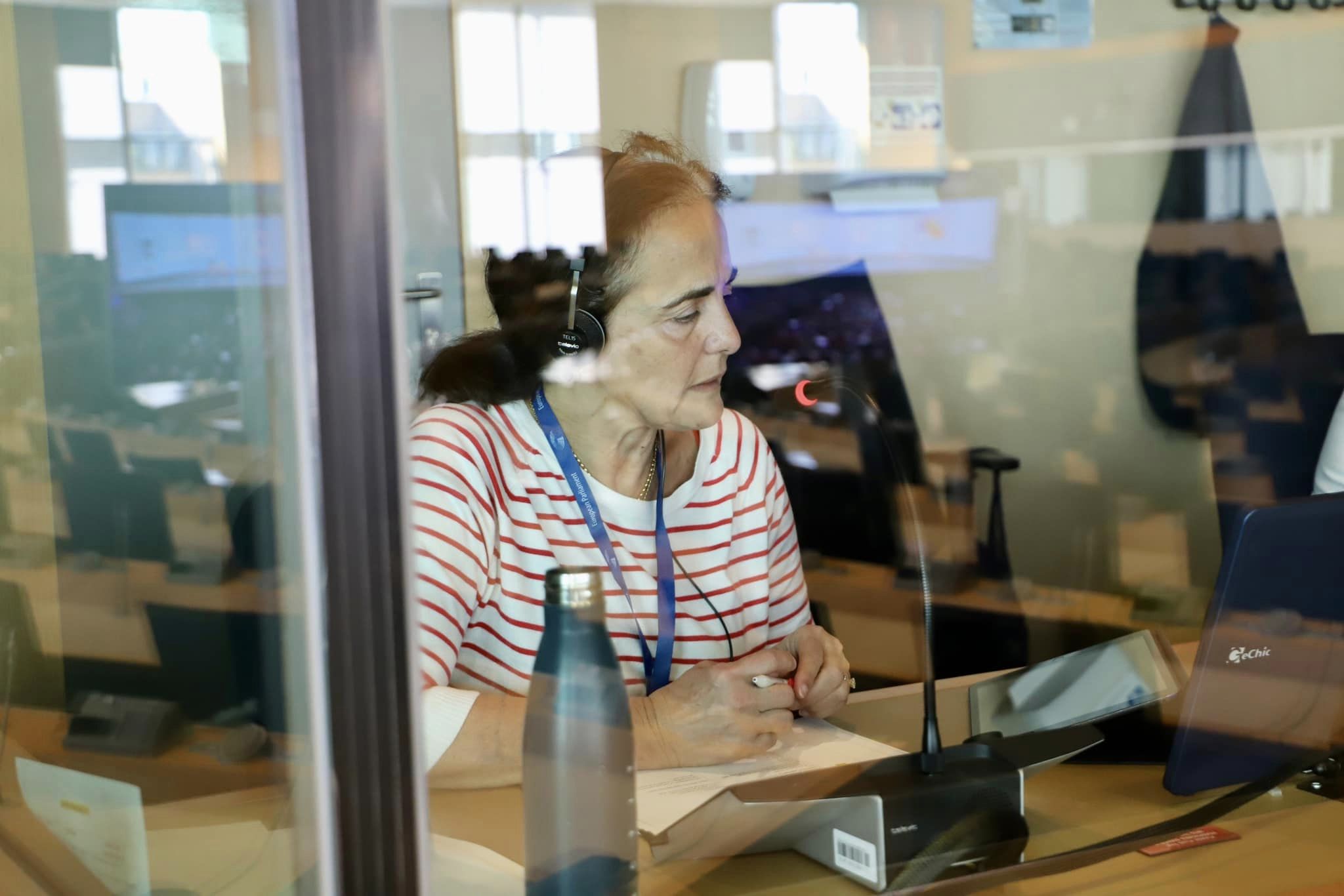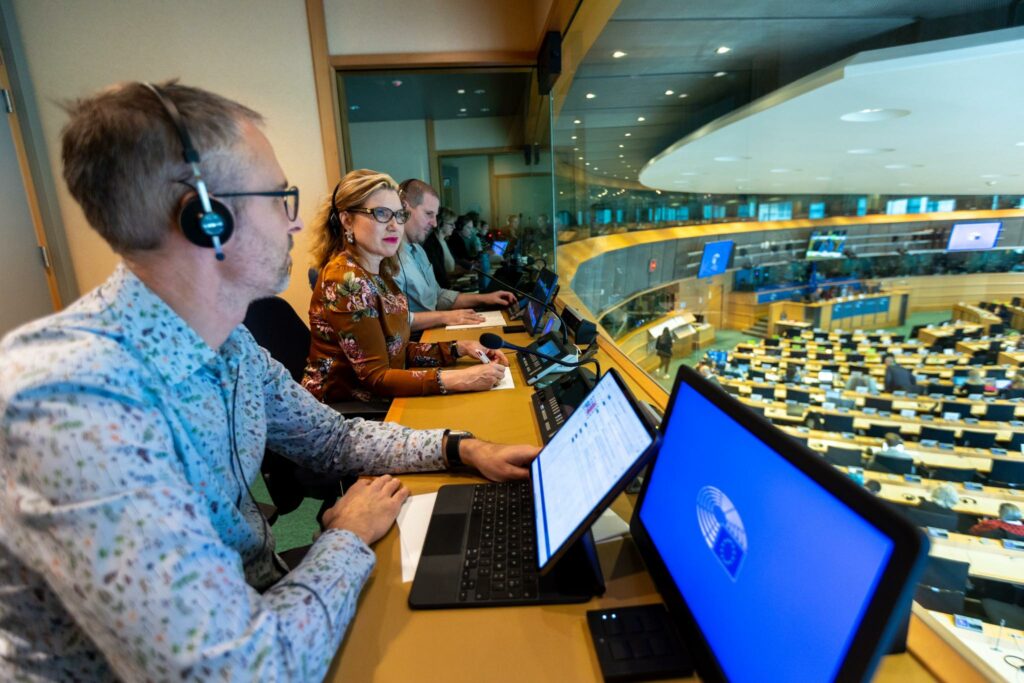As artificial intelligence creeps into our daily lives, professional linguists face the looming threat of being replaced by automatic translation. While this may be true for EU translation departments, which have downsized considerably in recent years, Ghent University researchers believe AI can be an invaluable asset for interpreters.
Earlier this month, the European Parliament's interpreting unit DG LINC announced a new training partnership with the Department of Translation, Interpreting and Communication at the University of Ghent's (UGent) revolutionary Computer-Assisted Interpreting (CAI) tool.
Led by experienced interpreter trainer and researcher in interpreting technologies Professor Bart Defrancq, the interactive sessions include an introductory lecture on AI, a glossary creation exercise, hands-on practice with the CAI tool while interpreting, and a feedback session at the end.
The workshops aim is to establish how useful, reliable and efficient the CAI tool is and how it should be further developed to meet the needs of interpreters in multilingual meetings.

Professor Bart Defrancq holding a training session with students at the European Parliament (Left) and the CAI transcription tool (Right). Credit: European Parliament Interpreters / Facebook
The AI-based tool offers simultaneous interpreters working in the booth a live transcript, numbers and technical terms, which can prove difficult to remember or translate on the spot.
Some interpreters find it extremely useful – and even asked Defrancq for a price quote after using it. Others, however, find the live transcript distracting and an overload of information in an already mentally-strenuous job.
"But, of course, the tool is not designed to be monitored all the time. I tell interpreters to ignore it as much as possible. But when you're in trouble, when you're lagging behind too much, when you missed a number, when you have no idea how to translate a term, then you can just look at the screen and incorporate this new information into your interpretation. It provides a safety net," Defrancq told The Brussels Times.
Currently, the tool can transcribe and extract information from six 'input languages' (French, English, German, Italian, Spanish and Dutch), but its creators are working on adding more. "We want to roll it out for the 24 official languages of the EU."
The CAI tool's creators also want to continue working on its automatic speech detection to avoid interpreters having to manually select an input language and glossary. "This causes problems if there's a sudden switch in language in the meeting," the professor explained. The team has therefore recently developed an automatic language detection module: the tool itself identifies the new language that is spoken, and selects a new glossary.

Credit: European Parliament Interpreters / Facebook
Although other AI tools such as InterpretBank and the remote simultaneous interpreting (RSI) platform Smarterp already exist, this particular CAI tool is only available at UGent and is still in its prototype phase. But the aim is to one day roll it out in international organisations such as the EU and UN.
On the private market, such a tool poses problems as it requires a strong WiFi connection (which may not always be possible when working in a remote location). The EU institutions are already one step ahead as they already have their own automatic speech recognition software and data are protected within their model.
"You need servers that are protected; you can't just have your speaker being transcribed somewhere on a server in the United States. You need to create a kind of ICT bubble in which you can work with no data leaks, and they have all that," Defrancq added.
'Stepping stone'
The researcher believes that the tool will be able to bridge the gap between newly-qualified and experienced interpreters. "It could facilitate the integration process of new interpreters in institutional groups, because there is currently an enormous gap between their education and the professional market, especially in institutions. Even if they pass the accreditation tests, they still find it very difficult to interpret meetings."
He ran a number of tests with the tool in real meetings with the European Commission's interpreting unit DG SCIC, and found that the AI-based technology was particularly appreciated among younger generations.
"This is not surprising, because they are digital natives and have screens around them all the time. But it's also a way of facilitating their work in the booth and catching up with more experienced people. It definitely provides a stepping stone for those entering the profession, as well as psychological support."
When interpreters are lagging behind or have missed a number, they are able to rely on the technology to catch up. It allows them a means of recovering a missing number, thereby easing stress. "For some interpreters, it's really comforting to know that, and it makes their lives easier and less stressful."
Related News
- Europeans and their languages: Is multilingualism dying in the EU?
- Interpreting or translating? How to get a job in the EU as a language lover
But for all its benefits, Defrancq stresses that interpreters cannot rely solely on the technology, and that maintaining a "critical mindset" is essential because it still makes mistakes. It is highly accurate for numbers, but there are often errors in names of organisations, people and acronyms – especially when the acronym is English but said by a German native speaker, for example.
Furthermore, when using AI to interpret a meeting without human intervention, there is a lack of accountability, confidentiality and the quality of communication is poorer.
"There is a general lack of accountability on behalf of the tech providers. If AI makes a mistake and decisions are based on that mistake, there is no one to blame because the user agreed to the terms and conditions."
Confidentiality also poses an issue as human interpreters are bound by their code of ethics; they cannot leak information from meetings, such as medical consultations or police interrogations. In contrast, there are no codes of ethics in tech companies.
In the EU, interpreters are mandatory in legal contexts and optional in medical consultations. But elsewhere, Google Translate is often used, providing the system with information from the criminal file. This is a real danger and "threatens basic values that we have here in the Western world."
Finally, AI gives a very basic quality of communication which falls well below what humans can provide. "The human connection is completely absent if you use apps to interpret or translate." Ordering a taxi or asking for information at a reception desk works well, for example, because it is factual and limited. Beyond this, it becomes more difficult, especially when nuance is needed.

English and Estonian interpreters working in booths during an EU meeting. Credit: Annika Haas / Wikimedia Commons
Market research firm CSA Research conducted a large-scale study in January 2024, commissioned by Interpreting SAFE-AI Task Force, to capture current perceptions about spoken and signed AI for interpreting, with a focus on the US market. Of those who tested or used the relevant AI-driven services for interpreting, a staggering 42% deemed the quality 'poor' and 14% labelled it as 'unacceptable'.
Although AI is undoubtedly becoming a competitor on the interpreting market, with some fully-automated systems already in use, it is clear that the available technology is still not (yet) satisfying enough of its users and there is a long way to go.
"AI isn't going to cause a collapse in the interpreting market, but we need to get the message out to the general public that these systems come with risks," Defrancq concluded.

